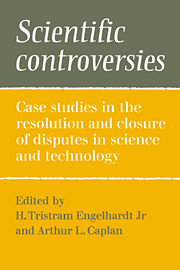 Scientific Controversies
Scientific Controversies Book contents
- Frontmatter
- Contents
- Preface
- List of contributors
- Introduction: Patterns of controversy and closure: the interplay of knowledge, values, and political forces
- PART I THEORETICAL PERSPECTIVES
- PART II CONTEMPORARY CASE STUDIES
- 12 Resolution of the Laetrile controversy: past attempts and future prospects
- 13 Federal regulation of Laetrile
- 14 Quasi libertarianism and the Laetrile controversy
- 15 Judicial deflection of scientific questions: pushing the Laetrile controversy toward medical closure
- 16 Politics, science, and the problem of psychiatric nomenclature: a case study of the American Psychiatric Association referendum on homosexuality
- 17 The diagnostic status of homosexuality in DSM-III: a reformulation of the issues
- 18 On arriving at the American Psychiatric Association decision on homosexuality
- 19 Values in the debate over workplace safety and health: the rancorous rhetoric about regulation
- 20 The successful experiment that failed
- 21 The power of efficiency: balancing benefits and costs in regulating occupational exposure to toxic substances
- 22 Closure in occupational safety and health: the benzene and cotton dust decisions
- 23 Nuclear fear: a history and an experiment
- 24 Closure and controversy: Three Mile Island
- 25 Understanding the nuclear power controversy
- PART III CONTROVERSY, CLOSURE, AND THE PUBLIC
- Author index
- Subject index
12 - Resolution of the Laetrile controversy: past attempts and future prospects
Published online by Cambridge University Press: 03 February 2010
- Frontmatter
- Contents
- Preface
- List of contributors
- Introduction: Patterns of controversy and closure: the interplay of knowledge, values, and political forces
- PART I THEORETICAL PERSPECTIVES
- PART II CONTEMPORARY CASE STUDIES
- 12 Resolution of the Laetrile controversy: past attempts and future prospects
- 13 Federal regulation of Laetrile
- 14 Quasi libertarianism and the Laetrile controversy
- 15 Judicial deflection of scientific questions: pushing the Laetrile controversy toward medical closure
- 16 Politics, science, and the problem of psychiatric nomenclature: a case study of the American Psychiatric Association referendum on homosexuality
- 17 The diagnostic status of homosexuality in DSM-III: a reformulation of the issues
- 18 On arriving at the American Psychiatric Association decision on homosexuality
- 19 Values in the debate over workplace safety and health: the rancorous rhetoric about regulation
- 20 The successful experiment that failed
- 21 The power of efficiency: balancing benefits and costs in regulating occupational exposure to toxic substances
- 22 Closure in occupational safety and health: the benzene and cotton dust decisions
- 23 Nuclear fear: a history and an experiment
- 24 Closure and controversy: Three Mile Island
- 25 Understanding the nuclear power controversy
- PART III CONTROVERSY, CLOSURE, AND THE PUBLIC
- Author index
- Subject index
Summary
One of the most remarkable features of the Laetrile controversy is its persistence. Although public attention and support of Laetrile treatment clearly reached a peak in the 1970s, Laetrile has a long and colorful history in the United States. Attempts to resolve the controversy surrounding it have been numerous and strikingly unsuccessful. In 1953 the Cancer Commission of the California Medical Association issued a document that concluded that “no satisfactory evidence has been produced to indicate any significant cytotoxic effect of Laetrile on the cancer cell.” Ten years later the Cancer Advisory Council to the director of California's Department of Public Health issued a report that found that Laetrile was of “no value in the diagnosis, treatment, alleviation or cure of cancer.” Upon the council's recommendation, in 1963 the California Department of Health banned the treatment of cancer with Laetrile.
Agencies of the federal government have also attempted to bring closure to the Laetrile controversy. As early as 1960, the Food and Drug Administration (FDA) conducted seizures of Laetrile and banned its shipment in interstate commerce. The FDA's right to regulate Laetrile was, however, challenged in a series of court cases in the late 1970s. As part of that controversy, the FDA commissioner, in a lengthy 1977 decision, ruled that Laetrile is not generally recognized by qualified experts as a safe and effective cancer drug and that it is not exempt from FDA regulation. Despite this decision, a judge issued a permanent injunction forbidding the FDA from restricting the importation and use of Laetrile.
- Type
- Chapter
- Information
- Scientific ControversiesCase Studies in the Resolution and Closure of Disputes in Science and Technology, pp. 315 - 332Publisher: Cambridge University PressPrint publication year: 1987
- 1
- Cited by


